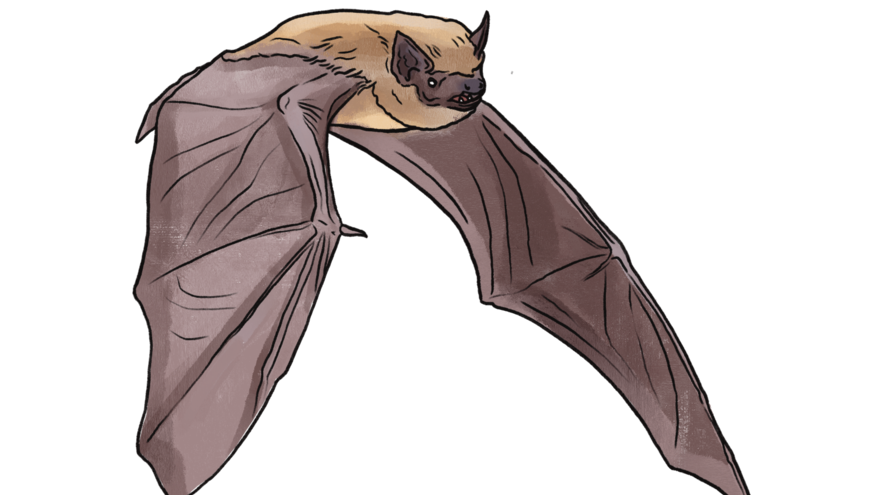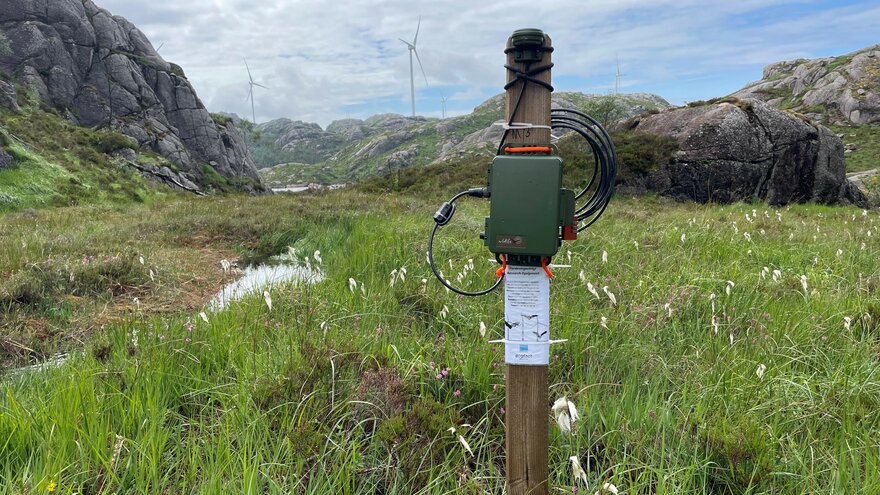About the lab
Our research
For more information about our group and our projects, please also visit our StoryMap!

Bats make up approximately 20% of Norway's terrestrial fauna where all 11 bat species are protected. However, there are significant knowledge gaps on bat populations and general ecology in Norway which inhibits management and conservation.
We use a broad range of methods including acoustic monitoring, mist netting, bat box monitoring, radio telemetry, genetic metabarcoding, as well as state of the art statistical tools and a diverse network of collaborators to approach research aims. Currently, on the Noctur project, we will use bat boxes and Motus receiver stations to capture, radio tag and track the movements of migrating bats along the southwest coast in Norway. You can read more about The Motus Wildlife Tracking System here. In this project, we also collect bat acoustic data to monitor bat activity as well as population dynamics at wind farms and along the coast. Additionally, we quantify the presence of insects to understand predator-prey dynamics using camera traps as well as with other methods.
We work closely with expert researchers in how quantitative analysis can be used to explain and model mammalian communities and behavior. Together we create spatial prediction models that can be used to predict future consequences for these populations.
In addition to scientific publications, we also carry out other forms of knowledge dissemination to the public, researchers, management, the consulting, and energy industries. We engage frequently with these aims through public outreach events, seminars, courses, and conferences.
A bat acoustic detector (Wildlife Acoustics Inc., Song Meter SM4BAT FS) deployed near a wind farm in Southwestern Norway. Photo: Bjarne Oddane Illustration: Olina Søyland Bru
Researchers

Mari Fjelldal
Post Doctor
Benedikte Øyen
Master's student
Sara Frida Linnéa Kristoffersson
Master's student
Ylva Heyn Friberg
Master's student
Research and results
Projects
Click on the links to read more about our projects.
Impacts of wind turbines on nocturnal flying wildlife - NocturMigratory bat activity in coastal Southwest NorwayScientific publications
Meierhofer, M. B., Tena, E., Lilley, T. M., Dechmann, D. K., Voigt, C. C., Troitsky, T. S., ... & Weller, T. J. (2024). Re‐weighing the 5% tagging recommendation: assessing the potential impacts of tags on the behaviour and body condition of bats. Mammal Review. https://doi.org/10.1111/mam.12369
Choiński, M., Zegarek, M., Hałat, Z., Borowik, T., Kohles, J., Dietzer, M., ... & Ruczyński, I. (2023, September). Insect detection on high-resolution images using deep learning. In International Conference on Computer Information Systems and Industrial Management (pp. 225-239). Cham: Springer Nature Switzerland.
Froidevaux, J. S., Toshkova, N., Barbaro, L., Benítez-López, A., Kerbiriou, C., Le Viol, I., ... & Razgour, O. (2023). A species-level trait dataset of bats in Europe and beyond. Scientific data, 10(1), 253.
McKay, R. A., Johns, S. E., Bischof, R., Matthews, F., van der Kooij, J., Yoh, N., & Eldegard, K. (2023). Wind energy development can lead to guild‐specific habitat loss in boreal forest bats. Wildlife Biology, e01168.
Sørås, R., Fjelldal, M. A., Bech, C., van der Kooij, J., Eldegard, K., & Stawski, C. (2023). High latitude northern bats (Eptesicus nilssonii) reveal adaptations to both high and low ambient temperatures. Journal of Experimental Biology, 226(21).
Sørås, R., Fjelldal, M. A., Bech, C., van der Kooij, J., Skåra, K. H., Eldegard, K., & Stawski, C. (2022). State dependence of arousal from torpor in brown long-eared bats (Plecotus auritus). Journal of Comparative Physiology B, 192(6), 815-827.
Sørås, R., Mckay, A. I., Van Der Kooij, J., & Eldegard, K. (2020). Recaptured Myotis brandtii carried glue-on radio-tag for 10 months: does time from tagging to shedding depend in timing of annual moulting. Journal of Bat Research and Conservation, 13, 60-65.
Posters
Reed April McKay, Ylva H. Friberg, Sara Kristoffersson, Benedikte Øyen, Fiona Mathews, Jeroen van der Kooij, Richard Bischof, Pierre Dupont, Ronny Steen, Bjarne Oddane, Geir A. Sonerud, Hans Ole Ørka & Katrine Eldegard (2023). Impacts of wind turbines on flying nocturnal wildlife. BatLife Sweden Conference, Jönköping, Sweden, 2023.
Reed McKay, Maris Pärn, Mara Zebele, Ylva Friberg, Sara Kristo ersson,
Benedikte Øyen, Fiona Mathews, Jeroen van der Kooij, Katrine Eldegard (2024). Resident and migratory bats and wind energy development in Southwest Norway. BatLife Sweden Conference, Helsingborg, Sweden, 2024.Technical reports
McKay, R.A.; Mathews, F. Eldegard, K. ‘Bats and Wind Turbines Onshore and Offshore. Norwegian national guidelines for monitoring surveys, assessments, and mitigation.’ The Norwegian Environment Agency. Submitted: September 2023. Unpublished.
McKay, R.A.; van der Kooij, J.; Mathews, F.; Eldegard, K. ‘Bats and wind energy infrastructure in Norway. Recommended pre- and post-construction monitoring protocol guidelines.' The Norwegian Environment Agency. Submitted: December 2020. Unpublished.
Master's theses
Fairchild, J. 2023. Identifying Valuable Habitat Types for Pipistrellus bat species in Norwegian Boreal Forests. Master thesis, Norwegian University of Life Sciences.
Johns, S. E. 2021. Bats, Insects and Weather: Spatial - Temporal Trends on a Boreal Forest Wind Facility in Norway. Master of Ecology, Norwegian University of Life Sciences.
Sætre, V. 2022. Monitoring bat-insect relationships in boreal forest habitats. Master thesis, Norwegian University of Life Sciences, Ås.
Thomle, M. K. 2023. Non-Invasive Monitoring of Insectivorous Bats and Insects in Boreal Forest Habitats. Master thesis, Norwegian University of Life Sciences.
